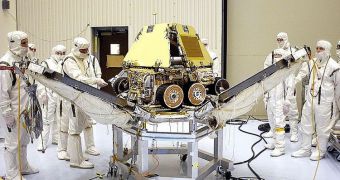Yesterday, January 3, the Mars Exploration Rover (MER) Spirit turned 8 since arriving on the surface of Mars. The spacecraft landed there on January 3, 2004, followed several days later by its sister rover, Opportunity. The latter arrived on January 25.
The two were supposed to operate for about three months, and drive around 600 meters on the surface of Mars. Their purpose was to locate any potential signs of past water among the sands and stones, and also to investigate how that water may have disappeared.
In time, mission controllers at the NASA Jet Propulsion Laboratory (JPL), in Pasadena, California, figured out that the two robots are a lot more resilient than they first thought. This was made obvious over the next few years, as the science mission continued on and on.
Overall, Spirit traveled for about 4.8 miles (7.72 kilometers), conducting a large number of very important geological experiments as it did so. Unfortunately, in May 2009, it became embedded in a path of loose Martian soil called Troy.
The sand was covered in a thick crust, which eventually gave way as the rover was traveling above it. All attempts to extricate the machine failed, and the situation became hopeless by May 2010. This was, in part, due to the fact that Troy was located at an angle that deprived Spirit of essential sunlight.
This was ultimately the cause of its demise, after spending so many winters on Mars. If Spirit were “alive” this week, it would mark its 8th anniversary on our neighboring planet. As it stands, only Opportunity remains now, and it will celebrate its own anniversary soon.
Though largely unnoticed by many of those who kept an eye on MER, Opportunity is the unsung hero of the mission, having exceeded record after record since arriving at Mars. Thus far, it traveled for more than 21.35 miles (34.36 kilometers).
The years haven't been kind to MER-B either. Some of its wheels constantly send out peculiar readings to mission controllers, while its robotic arm is malfunctioning at times. Still, that doesn't really matter after surviving so many years on another, extremely-cold planet.
“I seriously thought both Spirit and Opportunity would be finished by the summer of 2004. I am totally blown away by the thought that we are still planning sequences for Opportunity today, and that we only lost Spirit because of her limited mobility and bad luck of breaking through crusty soil to get bogged down in loose sands,” says Ray Arvidson.
The expert, who is based at the Washington University in St. Louis (WUSL), is the deputy principal investigator of the MER mission, Space reports.

 14 DAY TRIAL //
14 DAY TRIAL //